
In this PowerPoint presentation students will learn that contraction is a shortened form of two words. They will learn some common contraction rules, look at some commonly used contractions and then get to practice.

In this PowerPoint presentation students will learn that contraction is a shortened form of two words. They will learn some common contraction rules, look at some commonly used contractions and then get to practice.

Contractions Worksheet; can be used as small group, whole group or independent station work. Directions: Complete the missing part of each contraction equation.

This inquiry provides students with an opportunity to examine nine of China’s most impactful innovations and their contributions to the modern world. These innovations and inventions fall into three categories: 1) Communication innovations including, written language, paper, and printing; 2) Military innovations including the Great Wall of China, gunpowder, and fireworks, and; 3) Economic innovations including, common currency, silk, and the Silk Road. The Communication innovations were the widest ranging chronologically with written language appearing in the Shang Dynasty (1,600-1,046 BCE) and paper-making not happening until 100 BCE in the Wu Dynasty and then printing in the Tang Dynasty in the 7th and 8th centurie CE. Military innovations unfolded first with early fireworks and the parts of the Great Wall of China in Qin Dynasty (221-206 BCE). Gunpowder was developed in the Tang dynasty (9th century) and began to be used in rockets in 13th century. but was mostly built in Ming (14th – 17th CE). Economic innovations go all the way back to 3,000 BCE with the development of silk. Three thousand years late the Silk Road begins to open up and common currency appears with the Qin in 3rd century BCE.
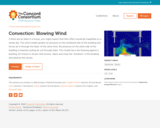
If there are air leaks in a house, you might expect that their effect would be magnified on a windy day. The wind creates greater air pressure on the windward side of the building and forces air in through the leaks. At the same time, the pressure on the other side of the building is lowered, pulling air out through leaks. This model has a fan blowing against a building. Air motion is shown with arrows. Open and close the "windows" in the building and observe the results.
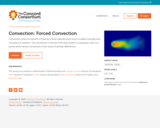
Convection refers to transfer of heat by a fluid material (such as air or water) moving from one place to another. The convection is forced if the fluid motion is caused by a fan or a pump while natural convection is the result of density differences.
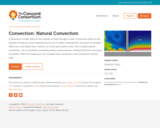
Conduction of heat refers to the transfer of heat through a solid. Convection refers to the transfer of heat by a fluid material (such as air or water) moving from one place to another. Warm air is less dense than cold air, so it rises and cold air sinks. This is called natural convection. Air is constantly circulating indoors and outdoors, moving heat from one place to another. With this model you can compare how conduction and convection transfer heat.

The convection of heat in air happens naturally because warmer air is less dense and rises, causing air circulation in many situations. But not always! Air can stratify, with warmer air up high and cooler air down low. With this model you can explore how convection works if the heat source is near the ceiling of a room. You can also compare it to conduction in the same setting.

Air circulates quickly and easily if there are temperature differences to drive its motion. This may be desirable in a room, but in insulated walls and ceilings air circulation is a problem, since it transfers heat. Explore the effect of multiple barriers on the amount of convection and apply this to how insulation should be designed.
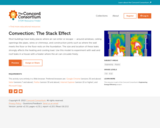
Most buildings have leaky places where air can enter or escape -- around windows, ceiling openings like pipes, wires or chimneys, and construction joints such as where the wall meets the floor or the floor rests on the foundation. The size and location of these leaks strongly affects the heating and cooling load. Use this model to experiment with wall and roof leaks in a house with a heater where the air can circulate freely.

A compilation of video scenarios of people interacting with each other in Portuguese. Conversations include dialogs, questions, turn taking exchanges, clarifications, false starts, hugs, laughter, asides. The scenarios are enhanced by transcriptions, translations, content analysis, and notes and discussion blogs.

Simple prompts on each slide guide a discussion about school culture, from clothing and food to homework, subject matter and sports. Sets the stage for cultural comparisons, study of "se impersonal," review and extension of beginner vocabulary. Prompts could subsequently be used as a writing or speaking assessment.

Conversation slides that help students review and use frequent vocabulary. What do you do before/after....?
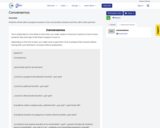
Students will be able to prepare answers to the conversation starters and then talk to their partners

Explore how potential energy created by particles of varying charge is converted to thermal energy.

Using proportions to convert between and among measurement systems.Mathematics Instructional Plans (MIPs) help teachers align instruction with the 2016 Mathematics Standards of Learning (SOL) by providing examples of how the knowledge, skills and processes found in the SOL and curriculum framework can be presented to students in the classroom.

Energy is continuously transferred from one place to another and transformed among various forms. In this lesson students will learn and demonstrate how energy is transferred from one form to another through various sequences. Additionally, they will explore binary code and how it can be converted from one form into another and transferred from one object to another.

Encourage students to use strategies to convert fractions to decimals.

Students will program a Sphero robot to travel around the exterior of a convex polygon. Students will then use the information in their code to determine the sum of the interior angles in a convex polygon.

Students will program a Sphero robot to travel around the exterior of a convex polygon. Students will then use the information in their code to determine the sum of the interior angles in a convex polygon.

Identify, write, represent, and compare fractionsMathematics Instructional Plans (MIPs) help teachers align instruction with the 2016 Mathematics Standards of Learning (SOL) by providing examples of how the knowledge, skills and processes found in the SOL and curriculum framework can be presented to students in the classroom.